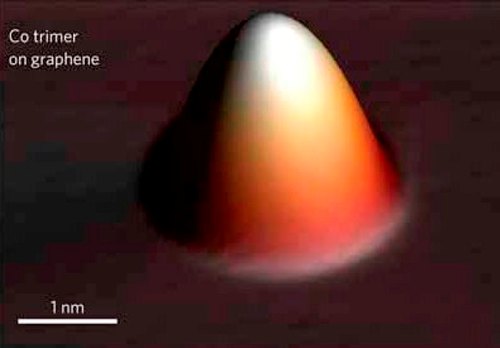Researchers at the U.S. Department of Energy and the University of California, Berkeley have been performing extensive research on graphene, one atom thick sheets of pure carbon through which electrons can move at the speed of light around 100 times quicker than they move in silicon.
 This zoom-in STM topograph shows one of the cobalt trimers placed on graphene for the creation of Coulomb potentials – charged impurities – to which electrons and holes could respond. (Image courtesy of Crommie group)
This zoom-in STM topograph shows one of the cobalt trimers placed on graphene for the creation of Coulomb potentials – charged impurities – to which electrons and holes could respond. (Image courtesy of Crommie group)
A scientist, Michael Crommie who has joint appointments with UC Berkeley’ Physics department and Berkeley Lab’s Materials Science Division was the lead researcher in a study wherein the initial direct observations of microscopic lengths were recorded of how holes and electrons respond to a charged impurity, which is a single Coulomb charge arranged on a gated graphene device. The results support the theory that electron interactions are significant to the outstanding properties of graphene.
Crommie stated that this research has shown that electrons in graphene behave strangely around charged impurities than other material electrons. The research has recorded first-time-ever images that ultra-relativistic electrons re-align themselves when they respond to a Coulomb potential proving that interactions between electrons are highly significant.
This study has been described in the journal Nature Physics with the paper titled “Mapping Dirac quasiparticles near a single Coulomb impurity on graphene”
Crommie added that in graphene, electrons act as Dirac fermions without any mass. How these electrons respond to a Coulomb potential is considerably different from how non-relativistic electrons behave in conventional impurity and atomic systems. However, a number of major theoretical predictions have not been tested yet.
The researchers worked with specially equipped scanning tunneling microscope in extremely high vacuum and studied gated devices comprising a graphene layer deposited on top of boron nitride flakes that were arranged on a silicon dioxide substrate.
In this research, cobalt trimers built on graphene by manipulating cobalt monomers with an STM tip have been used as the charged impurities.
The STM utilized to design the cobalt trimers was used for mapping the Dirac quasiparticle response- both hole-like and electron-like to the coulomb potential formed by the trimers. Comparison of the observed electron-hole asymmetry to theoretical simulations enabled the research team to not just test theoretical assumptions of how Dirac fermions behave close to a Coulomb potential, but also for the extraction of the dielectric constant of graphene.
The Office of Naval Research, the DOE Office of Science and the National Science Foundation supported the research.